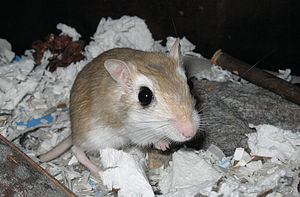Pale gerbil
| Pale gerbil | ||||||||||||
|---|---|---|---|---|---|---|---|---|---|---|---|---|

Pale gerbil |
||||||||||||
| Systematics | ||||||||||||
|
||||||||||||
| Scientific name | ||||||||||||
| Gerbillus perpallidus | ||||||||||||
| Setzer , 1958 |
The pale gerbil or pale gerbil ( Gerbillus perpallidus ) is an approx. 10 centimeter large representative of the long-tailed mouse family .
Appearance
These animals have a very light, sandy-colored, short coat with black shades. The abdomen, throat, and the area around the large, dark eyes are white. The long hind legs and the front legs and the long tail are only very insisted on being very faintly whitish. The head is short and the forehead is very flat and the large ears stick out only slightly.
distribution and habitat
The pale gerbil is only found in the desert regions of northern Egypt in an area west of the Nile Delta .
Way of life and reproduction
This species feeds mainly on plant seeds, roots and other parts of plants. They cover their fluid requirements almost exclusively through their food. They live together in smaller groups. They dig their long underground burrows in the local sand dunes. Your natural enemies e.g. B. Owls usually recognize them by noises in the infrasound range and by their large field of vision . The gestation period of the pale gerbil is 3–4 weeks. The size of their litter is very different, mostly there are 3–5 young, rarely 12. The maximum age is 2 years.
Use and harmful effects
When many of these animals appear in a confined space. their constructions can cause damage to buildings and roads. In addition, they are considered to be crop pests in some parts of their range. Fleas can transmit diseases such as the plague or leishmaniasis to humans. They are only occasionally hunted for their meat, and humans also keep this species as pets .
Hazards and protective measures
Since this species is still relatively widespread and no specific threats are known, the IUCN lists it as ( Least Concern ) safe.
literature
- Esther Verhoef: Illustrated rabbit and rodent encyclopedia p. 108, 109 Publisher: Dörfler Verlag GmbH June 1, 2007 ISBN 978-3-89555-420-9
- David Mac Donald: Encyclopedia of Mammals Pages 652–655 Publisher: KÖNNEMAN, Königswinter 2003 (German translation from English) ISBN 3-89731-928-4
Web link
- Gerbillus perpallidus inthe IUCN Red List of Threatened Species 2018.1. Posted by: Aulagnier, S., Schlitter, D. & Granjon, L., 2008. Retrieved October 28, 2018.